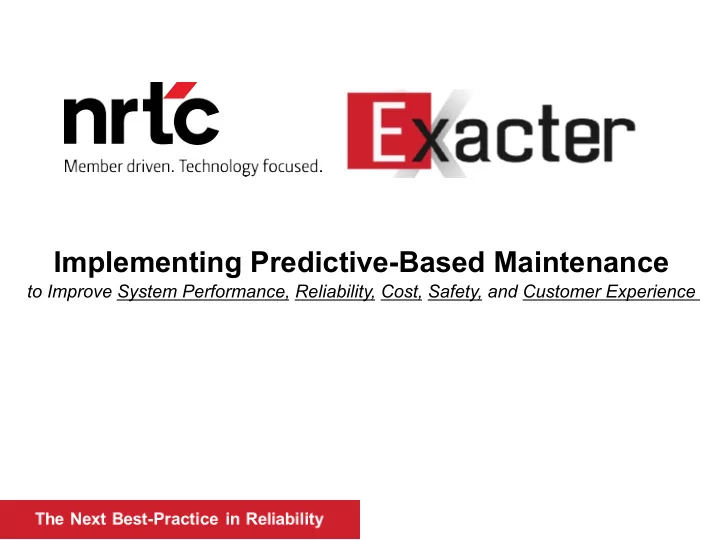

Implementing Predictive-Based Maintenance to Improve System Performance, Reliability, Cost, Safety, and Customer Experience
August 2015: NEETRAC, NRECA Agree • Aging equipment, higher expectations for reliability, and cost constraints on the rise • NRECA’s CRN: “High level of interest in prioritization of asset management” • Effectiveness of current maintenance programs in doubt
October 2015: T&D World The impact of replacing equipment BEFORE the outage
Intelligence for Smarter Investments & Improved Reliability What would it mean to your Utility and Members if you could: Enable PdM across the distribution system: Employ a proactive asset risk management strategy • Preventive vs. Conditions-based approach Optimize maintenance operations • Understand exactly where your risks are across the system • Efficiently target and plan maintenance strategies • Minimize cost of run-to-failure operations to predictive processes Significantly improve cost - reliability/system performance • Achieve 20%-40% improvement in EQ-Related SAIDI • Do so by only addressing 10% - 20% of overhead miles • Do so at about $1 per meter Optimize budget/planning cycles • Potentially defer/re-prioritize capital projects
Advantages of a PdM Process Framework Objective • Two technologies & proprietary analysis capture and assess problematic conditions • PD & EMI are the primary characteristic of equipment degradation, contamination, & failure Repeatable • Assessments are not load dependent • Assessments are not impacted by ambient environmental conditions Trendable • Repeatable assessments will enable trend analysis of system performance Scalable • Cover large territories and receive results in 4-7 weeks Actionable • Identify 1 component every 8 to 12 miles • Assign Criticality Measure • Single-source data can be used to deliver multiple benefits
Exacter Enables PdM Strategies for Utility Operations & Asset Management A reliability strategy that assesses the condition of equipment while in service to determine the appropriate maintenance operation to avoid interruption or equipment failure. 1) Proactive – Transition from reactive restoration 2) Targeted – Assess where Equipment related issues occur – Critical Infrastructure (serves the greatest # of customers) – 1 component every 8 –12 miles 3) Measurable – Pre-assessment: Identify opportunity for improvement – Assessment: Validate opportunity for improvement – Post-Assessment: Track progress towards achieving goals Cost effectively improve performance & reliability
RF Emissions are Leading Indicators of Risk Capturing these asset health measures enable proactive maintenance
Predictive Process 1) Data Analysis / 2) Exacter 3) Field Report & 4) Metrics & Criticality Measure Project Proposal Technology Benefits Engineers produce With utility provided Patented Exacter RF Exacter will work with field report with CMI data: technology scan utility to define metrics assessment findings: for success - Historical trend - Captures PD/EMI - Integrates with OMS analysis to identify Metrics - Real time analysis & WMS (.CSV) system performance 1) OH EQ CMI of Proprietary Analytics “baseline” - Available in GIS assessed circuits formats - Identify structure 2) Assessed circuits v. - Identify where location with non-assessed equipment related With utility provided degraded outages occur on GIS & Connectivity 3) EQ CMI v. System component distribution CMI data: overhead Ultrasonic Technology Benefits - Show how many - Provide optimized customers would be 1) Avg. Annual EQ - Engineers visit project impacted if CMI Reduction structures and recommendations equipment fails confirm degraded 2) Avg. Annual EQ for greatest system - Prioritize component SAIDI Reduction improvement maintenance based 3) EQ CMI v. System on impact on CMI distribution system
The “New Normal” – using Predictive Maintenance
Experiencing the “new normal” Eastern Utility
Recent projects/successes
Thank You
Asset Health Assessment - Deliverable Example
Asset Health Assessment – Deliverable Example
True Grid Condition Assessment for Improved System Resiliency and Reliability § Based in Columbus, OH § NRTC Partnership in May 2015 § Focus on Predictive-Based Maintenance § Proven customer success § Vetted technology § 5 US Patents, 7 Int’l Patents § 3 rd Party Validation – U.S. Dept. of Energy (DOE) – Nat’l Elec. Testing Lab (NETL) – The Ohio State University
Using Asset Health Analytics for Asset Management and Operations Improve system performance & resiliency Reduce CMI, SAIDI, SAIFI & other related performance indices • Reduce the duration of equipment related outages • Reduce the frequency of equipment related outages Pre/post storm impact assessments: restoration vs repairs Identify evolving trends in equipment, root cause issues over time: “root-out” targeted equipment Identify any potential safety concerns PRIOR to sending crews to do work: eg. porcelain cut-outs Transition from reactive outage restoration to predictive-based maintenance for overhead equipment • Reduce costs associated with reactive operations due to equipment failure
Recommend
More recommend